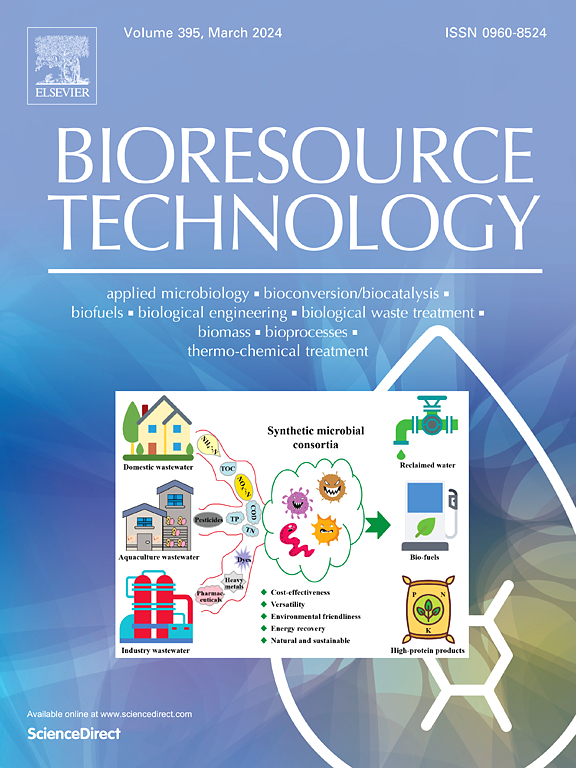pH值调整增加了抑制柳枝稷水解物的生物燃料生产。
IF 9.7
1区 环境科学与生态学
Q1 AGRICULTURAL ENGINEERING
引用次数: 0
摘要
从可再生和可持续的木质纤维素生物质(如柳枝稷)中提取的生物燃料为限制温室气体排放提供了一种有希望的方法。然而,在干旱条件下生长的柳枝稷含有大量抑制微生物转化为生物燃料的化合物。工程酿酒酵母菌和活动单胞菌发酵干旱柳枝稷水解产物的乙醇产量低于典型降雨年份发酵水解柳枝稷的乙醇产量。本研究表明,通过改变两种预处理方法(氨纤维膨胀法(AFEX)和氨水浸泡法(SAA))产生的干旱柳枝稷水解液的pH值,可以减轻这种抑制作用。采用两种预处理方法后,所有原料年份的发酵速率和生物燃料产量在pH为5.8时均高于pH为5.0时。与AFEX预处理相比,SAA预处理干旱柳枝稷进一步提高了发酵率和生物燃料滴度。开发了柳枝稷水解物的合成模拟物,并确定了木质纤维素衍生抑制剂对pH依赖性抑制的缓解,这是pH高于5.0时生物燃料产量增加的原因。这些结果表明,SAA预处理和pH调节可以显著改善工业微生物对抑菌原料的发酵和生物燃料的生产。本文章由计算机程序翻译,如有差异,请以英文原文为准。
pH adjustment increases biofuel production from inhibitory switchgrass hydrolysates
Biofuels derived from renewable and sustainable lignocellulosic biomass, such as switchgrass, offer a promising means to limit greenhouse gas emissions. However, switchgrass grown under drought conditions contains high levels of chemical compounds that inhibit microbial conversion to biofuels. Fermentation of drought switchgrass hydrolysates by engineered Saccharomyces cerevisiae and Zymomonas mobilis results in lower ethanol production than does fermentation of hydrolyzed switchgrass from a typical rainfall year. Here, it is demonstrated that this inhibitory effect can be alleviated by altering the pH of drought switchgrass hydrolysates produced by two different pretreatment methods: Ammonia Fiber Expansion (AFEX) and Soaking in Aqueous Ammonia (SAA). Fermentation rates and biofuel production by Saccharomyces cerevisiae and Zymomonas mobilis were higher at pH 5.8 than at pH 5.0 from all feedstock years and following both pretreatment methods. SAA pretreatment of drought switchgrass furthermore enabled increased fermentation rates and biofuel titers compared to AFEX pretreatment. A synthetic mimic of switchgrass hydrolysate was developed and identified relief from pH-dependent inhibition by lignocellulose-derived inhibitors as the cause of increased biofuel production above a pH of 5.0. These results demonstrate that SAA pretreatment and pH adjustment can significantly improve fermentation and biofuel production from inhibitory feedstocks by industrial microorganisms.
求助全文
通过发布文献求助,成功后即可免费获取论文全文。
去求助
来源期刊

Bioresource Technology
工程技术-能源与燃料
CiteScore
20.80
自引率
19.30%
发文量
2013
审稿时长
12 days
期刊介绍:
Bioresource Technology publishes original articles, review articles, case studies, and short communications covering the fundamentals, applications, and management of bioresource technology. The journal seeks to advance and disseminate knowledge across various areas related to biomass, biological waste treatment, bioenergy, biotransformations, bioresource systems analysis, and associated conversion or production technologies.
Topics include:
• Biofuels: liquid and gaseous biofuels production, modeling and economics
• Bioprocesses and bioproducts: biocatalysis and fermentations
• Biomass and feedstocks utilization: bioconversion of agro-industrial residues
• Environmental protection: biological waste treatment
• Thermochemical conversion of biomass: combustion, pyrolysis, gasification, catalysis.
 求助内容:
求助内容: 应助结果提醒方式:
应助结果提醒方式:


